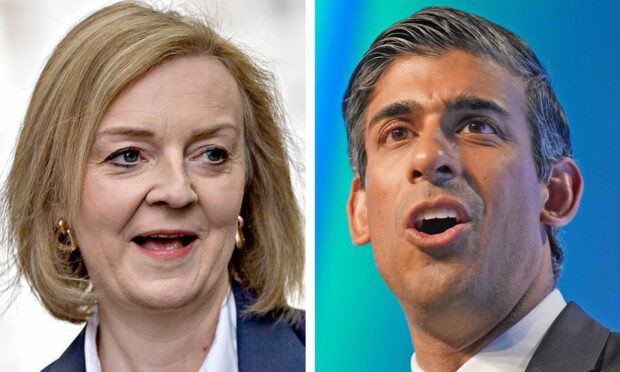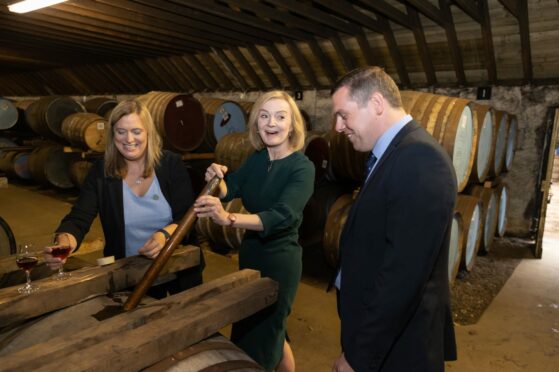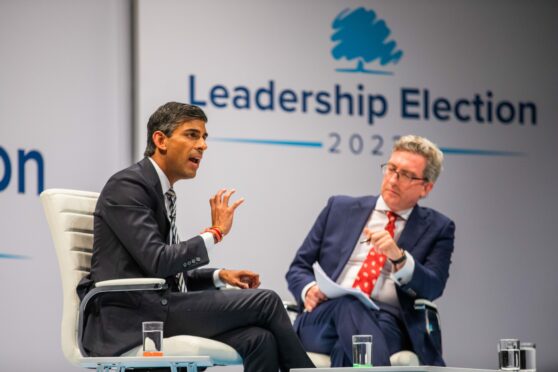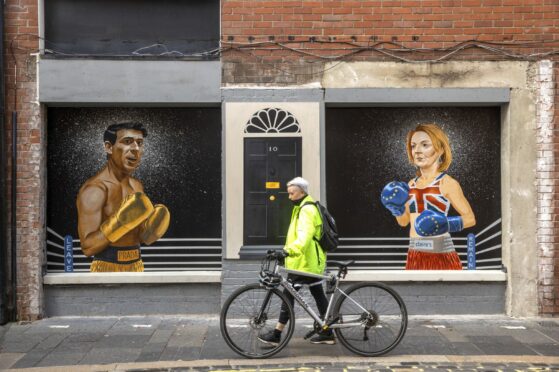Rishi Sunak and Liz Truss set out their plans to halt another independence referendum, but clashed over competing Tory policies to sort out a cost-of-living crisis.
Both candidates set out their stall to supporters in Perth Concert Hall on Tuesday night.
Their plans will have long-term consequences for everyone in the UK.
But a tiny fraction of the electorate will be making that decision without a general election.
Here are the hot topics on the constitution, taxes, energy and the economy you need to know.
1. Taking on ‘attention seeking’ Nicola Sturgeon
This was the only Scottish leader debate for the pair – and the constitution was a major talking point.
Ms Truss said she would not allow another independence referendum as prime minister, which got a huge cheer from the audience.
She repeatedly called herself a “child of the union” and referenced her childhood in Paisley, saying she had a strong Scottish accent as a youngster.
Ms Truss said: “To me, we are not neighbours, we are family and I will never let our family be split up.”
Mr Sunak appeared cautious to a question ruling out any future independence referendum. But he said it is “barmy” to focus on an “unnecessary and divisive” referendum.
He added: “I don’t want to just ignore Nicola Sturgeon, I want to take her on and beat her.”
Both took personal swipes at Ms Sturgeon and her SNP government, on issues such as education and public transport.
In another signal of cross-government conflict, Mr Sunak said he would bypass Holyrood when he could.
He admitted to being disappointed some Scots thought furlough money during the coronavirus pandemic came from Holyrood and not him as chancellor.
2. Can they respond to the cost of living crisis?
Whoever wins, there is an economic crisis to deal with.
But both have very different ideas, setting off the strongest disagreements between the candidates.
Mr Sunak said “inflation is the enemy” and despite being the former chancellor, he blamed Ms Sturgeon for not taking inflation seriously enough.
When it came to how he would support struggling families, Mr Sunak relied on his record.
He did however say he would cut VAT further, cut the rate of income tax and would not “risk policies that will make inflation worse”.
Ms Truss said she has always been “low tax” and would reverse the national insurance rise.
Again referencing her brief time in Paisley in the 1980s, she told the audience she knows what “difficult economic times looks like”.
But her tax plan was branded a “moral failure”, showing even the Conservatives have serious concerns about policies coming from their own side.
3. Energy, green levies and fossil fuels
Both candidates seem keen to keep the taps running in the North Sea oil and gas industry.
Mr Sunak said the industry could secure the UK’s energy supply “for decades to come”.
When it came to the transition to low-carbon jobs, he refused to say whether he would fund a carbon capture project in Peterhead.
He claimed credit for funding £1 billion for similar schemes across the UK as a whole instead.
Ms Truss, who had earlier been in Aberdeen, said the north-east’s “fantastic” oil and gas industry could be used to help resource the UK’s domestic gas supply.
She also said the UK Government didn’t invest in nuclear energy early enough and didn’t put the right incentives in place when it comes to oil and gas.
Ms Truss also pledged to deliver controversial “freeports” with special tax status in Scotland – something Mr Sunak already claims the credit for arranging.
4. Sticking by ‘inhumane’ Rwanda immigration policy
One of the most controversial Tory policies over the past 12 months has been the introduction of a scheme to send asylum seekers to Rwanda.
While neither candidate wants to scrap the law, Mr Sunak came under unexpected pressure from one party member in the audience who branded it “inhumane”.
Mr Sunak said immigrants must arrive in Britain “legally”, and Ms Truss wants to extend the scheme to other countries and stop boats arriving from across the Channel.
Both candidates tried to win over the audience with mentions of Brexit, but Ms Truss came under pressure for backing the Remain campaign in 2016.
She attempted to brush off claims it was hypocritical to deny another independence referendum even though she had changed her mind on leaving the EU.
5. What happens next?
Both candidates will be in Northern Ireland on Wednesday for a hustings in Belfast, with events to follow in Manchester, Birmingham and London.
Ms Truss remains favourite to win. For Mr Sunak, the next fortnight will be an uphill task as he works desperately to regain lost ground on his rival.
The winner will be announced on September 5 once Tory members have made up their minds.



